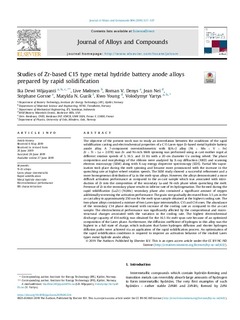| dc.contributor.author | Wijayanti, Ika Dewi | |
| dc.contributor.author | Mølmen, Live | |
| dc.contributor.author | Denys, Roman Volodymyrovich | |
| dc.contributor.author | Nei, Jean | |
| dc.contributor.author | Gorsse, Stéphane | |
| dc.contributor.author | Guzik, Matylda N. | |
| dc.contributor.author | Young, Kwo | |
| dc.contributor.author | Yartys, Volodymyr | |
| dc.date.accessioned | 2019-07-25T08:36:01Z | |
| dc.date.available | 2019-07-25T08:36:01Z | |
| dc.date.created | 2019-07-19T12:02:12Z | |
| dc.date.issued | 2019 | |
| dc.identifier.citation | Journal of Alloys and Compounds. 2019, 804 527-537. | nb_NO |
| dc.identifier.issn | 0925-8388 | |
| dc.identifier.uri | http://hdl.handle.net/11250/2606445 | |
| dc.description.abstract | The objective of the present work was to study an interrelation between the conditions of the rapid solidification casting and electrochemical properties of a C15 Laves-type Zr-based metal hydride battery anode alloy. A 7-component overstoichiometric with B/A>2 alloy (Ni + Mn + V + Fe/Zr + Ti + La = 2.078) was Zr- and Ni-rich. Melt spinning was performed using as cast mother ingot at different rotation speeds of 5, 16.5, and 33 Hz with a 20-cm diameter Cu cooling wheel. The phase composition and morphology of the ribbons were analyzed by X-ray diffraction (XRD) and scanning electron microscopy (SEM) along with X-ray energy dispersive spectroscopy (EDS). Partial Mn vaporization took place during the melt spinning and became more pronounced with the increase in the quenching rate at higher wheel rotation speeds. The SEM study showed a successful refinement and a more homogeneous distribution of La in the melt-spun alloys. However, the alloys demonstrated a more difficult activation performance as compared to the as-cast sample which was associated with introduction of Zr into the composition of the secondary La-and Ni-rich phase when quenching the melt. Presence of Zr in the secondary phase results in inferior rate of its hydrogenation. The formed during the rapid solidification (La,Zr) (Ni,Mn) secondary phase also contained a significant amount of oxygen additionally worsening the activation performance. The grain size gradually decreased from 3.5 μm in the as-cast alloy to approximately 250 nm for the melt spun sample obtained at the highest cooling rate. The two-phase alloys contained a mixture of two Laves type intermetallics, C15 and C14 ones. The abundance of the secondary C14 phase decreased with increase of the cooling rate as compared to the as-cast sample. The electrochemical performance was significantly affected by the compositional and microstructural changes associated with the variation in the cooling rate. The highest electrochemical discharge capacity of 414 mAh/g was obtained for the 16.5 Hz melt spun rate because of an optimized composition of the Laves phase. Furthermore, the diffusion coefficient of hydrogen in this alloy was the highest in a full state of charge, which indicates that faster hydrogen diffusion and shorter hydrogen diffusion paths were achieved via an application of the rapid solidification process. An optimization of the rapid solidification conditions is required to improve an activation behavior of the studied Laves types metal hydride anode alloys. | nb_NO |
| dc.language.iso | eng | nb_NO |
| dc.publisher | Elsevier | nb_NO |
| dc.rights | Attribution-NonCommercial-NoDerivatives 4.0 Internasjonal | * |
| dc.rights.uri | http://creativecommons.org/licenses/by-nc-nd/4.0/deed.no | * |
| dc.title | Studies of Zr-based C15 type metal hydride battery anode alloys prepared by rapid solidification | nb_NO |
| dc.type | Journal article | nb_NO |
| dc.type | Peer reviewed | nb_NO |
| dc.description.version | publishedVersion | nb_NO |
| dc.source.pagenumber | 527-537 | nb_NO |
| dc.source.volume | 804 | nb_NO |
| dc.source.journal | Journal of Alloys and Compounds | nb_NO |
| dc.identifier.doi | 10.1016/j.jallcom.2019.06.324 | |
| dc.identifier.cristin | 1712063 | |
| dc.relation.project | Norges forskningsråd: 257653 | nb_NO |
| dc.description.localcode | © 2019 The Authors. Published by Elsevier B.V. Open Access. CC BY-NC-ND 4.0 | nb_NO |
| cristin.unitcode | 194,66,35,0 | |
| cristin.unitname | Institutt for materialteknologi | |
| cristin.ispublished | true | |
| cristin.fulltext | postprint | |
| cristin.qualitycode | 1 | |

